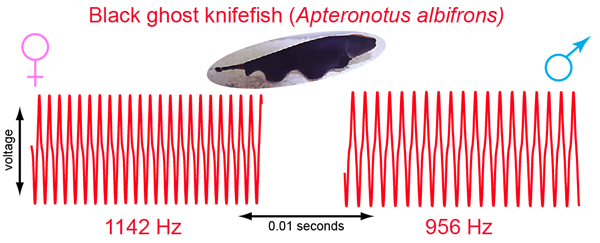Learn About Electric Fish
Sex differences in EODs
In many species of electric fish, EOD frequency (i.e., the rate at which the fish discharges its electric organ) differs between males and females. Both the magnitude and the direction of sex differences in EOD frequency vary across species.
In the brown ghost knifefish (Apteronotus leptorhynchus), males discharge their electric organs at higher rates than females. Adult male A. leptorhynchus EODs are typically emitted at frequencies of 850-1100 Hz, whereas femalestypically have EOD frequencies of 600-800 Hz.
 |
Sex differences in the EOD of brown ghost knifefish (A. leptorhynchus). Photographs of female and male brown ghost knifefish with voltage traces of their EODs below. EOD of the female EOD of the male Notice that the male EOD is higher in frequency (pitch) than the female EOD. (Based on recordings from Kolodziejski et al. 2005) |
In some populations of the black ghost knifefish (Apteronotus albifrons), EOD frequency is also sexually dimorphic, but the direction of the sex difference is reversed. Males have significantly lower EOD frequencies than females. Male EODs are emitted at frequencies of 850-1000 Hz, whereas female EOD frequencies are typically 1000-1150 Hz. Our laboratory recently discovered that in other populations of black ghost knifefish, EOD frequency does not differ between the sexes (see our research page for more details).
 |
Sex differences in the EOD of black ghost knifefish (A. albifrons) from the Orinoco river drainage. A photograph of a black ghost knifefish with voltage traces of female and male EODs below. EOD of the female EOD of the male Notice that unlike the brown ghost knifefish, the male EOD is lower in frequency than the female EOD. (Based on recordings from Kolodziejski et al. 2005) |
Sex differences in EOD frequency are regulated by androgens (11-ketotestosterone, 11-KT) and estrogens. The effects of hormones are reversed in brown and black ghost knifefish (Dunlap et al. 1998). In brown ghost knifefish, 11-KT masculinizes EODs by increasing thier frequency. 11-KT also masculinizes EOD frequency in sexually dimorphic populations of black ghost knifefish, but because males in this species have lower EOD frequencies than females, 11-KT lowers rather than raises EOD frequency. We are particularly interested in understanding how the hormonal mechanisms underlying such reversals in sex differences have evolved.
Research projects in our laboratory are aimed at the following:
- Characterizing species diversity in the direction and magnitude of sex differences in EOD frequency to understand how sexual dimorphism evolved.
- Understanding the hormonal and neural mechanisms that underlie sex differences in EOD frequency and how these mechanisms differ across species.
- Investigating how male and female fish of different species respond to EODs of different frequencies to understand how the function of the EOD as a communication signal has evolved.
